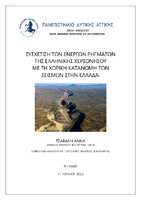| dc.contributor.advisor | Tsatsaris, Andreas | |
| dc.contributor.author | Τζαβαλή, Άννα | |
| dc.date.accessioned | 2023-07-13T11:54:59Z | |
| dc.date.available | 2023-07-13T11:54:59Z | |
| dc.date.issued | 2023-07-11 | |
| dc.identifier.uri | https://polynoe.lib.uniwa.gr/xmlui/handle/11400/4664 | |
| dc.identifier.uri | http://dx.doi.org/10.26265/polynoe-4502 | |
| dc.description.abstract | Η παρούσα διπλωματική εργασία παρουσιάζει τη χωρική κατανομή των σεισμικών γεγονότων που έλαβαν χώρα στην Ελλάδα τα έτη 1964 έως 2022. Σκοπός, είναι η συσχέτιση των σεισμών που έλαβαν χώρα στον ελλαδικό χώρο με τα χαρακτηριζόμενα ως ενεργά ρήγματα της Ελλάδας.
Τα διαθέσιμα δεδομένα των σεισμών προήλθαν από το Γεωδυναμικό Ινστιτούτο, τα οποία είναι ανοιχτά και προσβάσιμα από όλους τους πολίτες, ενώ τα ρήγματα που μελετώνται, προέρχονται από την Ελληνική Γεωλογική Εταιρεία το 2010 και συνοδεύονται από άρθρο με τον τίτλο «The Greek Catalogue of Active Faults and Database of Seismogenic Sources. Για τα σεισμικά γεγονότα δίδονται η ημερομηνία, οι συντεταγμένες (φ, λ), το βάθος και το μέγεθος στην κλίμακα Richter. Δημιουργήθηκε ένας πίνακας μέσω του περιβάλλοντος τουExcel όπου, εμπεριέχονται όλα τα δεδομένα με τη σωστή ταξινόμηση, ομαδοποίηση και κωδικοποίηση ώστε να είναι συμβατά με το λογισμικό που χρησιμοποιήθηκε.
Τα παραπάνω δεδομένα υποβλήθηκαν σε γεωχωρική επεξεργασία που περιελάμβανε τη γεωστατιστική μέθοδο Kernel density estimation, η οποία υλοποιείται μέσω του λογισμικού ArcMap και παρουσιάζεται αναλυτικότερα στη συνέχεια της διπλωματικής εργασίας.
Επίσης, παρουσιάζονται χάρτες οι οποίοι εμφανίζουν τα σεισμικά γεγονότα που συλλέχθηκαν και τα ενεργά ρήγματα της Ελληνικής Χερσονήσου, ώστε να ερευνήσουμε εάν υπάρχει συσχέτιση μεταξύ τους. Πραγματοποιείται χωρική στατιστική ανάλυση για τη διερεύνηση της σχέσης μεταξύ των επικέντρων, των εστιακών βαθών και των αποστάσεων από τα ρήγματα. Από αυτές τις μεθόδους, παράγονται επίσης χάρτες που βοηθούν στην οπτικοποίηση, συνεπώς και στην κατανόηση, των αποτελεσμάτων. Τέλος, αναλύονται τα αποτελέσματα και απαντώνται τα ερωτήματα που τίθενται από την αρχή της εργασίας αυτής. | el |
| dc.format.extent | 71 | el |
| dc.language.iso | el | el |
| dc.publisher | Πανεπιστήμιο Δυτικής Αττικής | el |
| dc.rights | Αναφορά Δημιουργού - Μη Εμπορική Χρήση - Παρόμοια Διανομή 4.0 Διεθνές | * |
| dc.rights | Attribution-NonCommercial-NoDerivatives 4.0 Διεθνές | * |
| dc.rights.uri | http://creativecommons.org/licenses/by-nc-nd/4.0/ | * |
| dc.subject | Σεισμοί | el |
| dc.subject | Χωρική ανάλυση | el |
| dc.subject | Χωρική στατιστική | el |
| dc.subject | ΣΓΠ | el |
| dc.title | Συσχέτιση των ενεργών ρηγμάτων της ελληνικής χερσονήσου με τη χωρική κατανομή των σεισμών στην Ελλάδα | el |
| dc.title.alternative | Correlation of the active faults of the Greek peninsula with the spatial distribution of earthquakes in Greece | el |
| dc.type | Διπλωματική εργασία | el |
| dc.contributor.committee | Krassanakis, Vassilios | |
| dc.contributor.committee | Κάτσιος, Ιωάννης | |
| dc.contributor.faculty | Σχολή Μηχανικών | el |
| dc.contributor.department | Τμήμα Μηχανικών Τοπογραφίας και Γεωπληροφορικής | el |
| dc.description.abstracttranslated | paper presents the spatial distribution of seismic events that took place in Greece between 1964 and 2022. The aim is to correlate the earthquakes that took place in Greece with the characterized as active faults in Greece.
The available data came from the Geodynamic Institute, which is open and accessible to all citizens while the faults come from the Hellenic Geological Society and created in 2010 and are accompanied by an article entitled “The Greek Catalog of Active Faults and Database of Seismogenic Sources. The date, the coordinates (φ, λ), the depth and the magnitude of the seismic events are given. A table was created through the Excel environment that includes all the data with the correct sorting, grouping, and encoding to be compatible with the software used.
The above data were subjected to geospatial processing which included the geostatistical method Kernel Density estimation, which is implemented through the ArcMap software and is presented in more detail later in the dissertation.
Also, maps are presented that show the seismic events collected and the active faults of the Greek Peninsular, in order to investigate if there is a correlation between them. Spatial statistical analysis is performed to investigate the relationship between epicenters, depth and distances from faults. From these methods, maps are also produced that help to visualize, and therefore to understand, the results. At the end, the results are analyzed and the questions posed from the beginning of this work are answered. | el |



